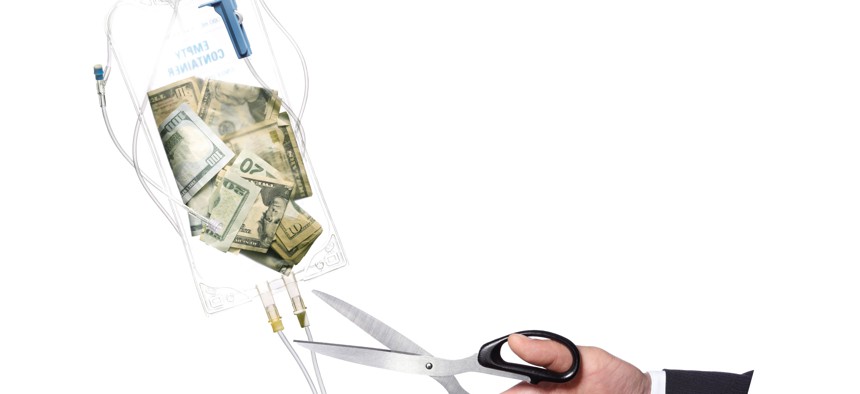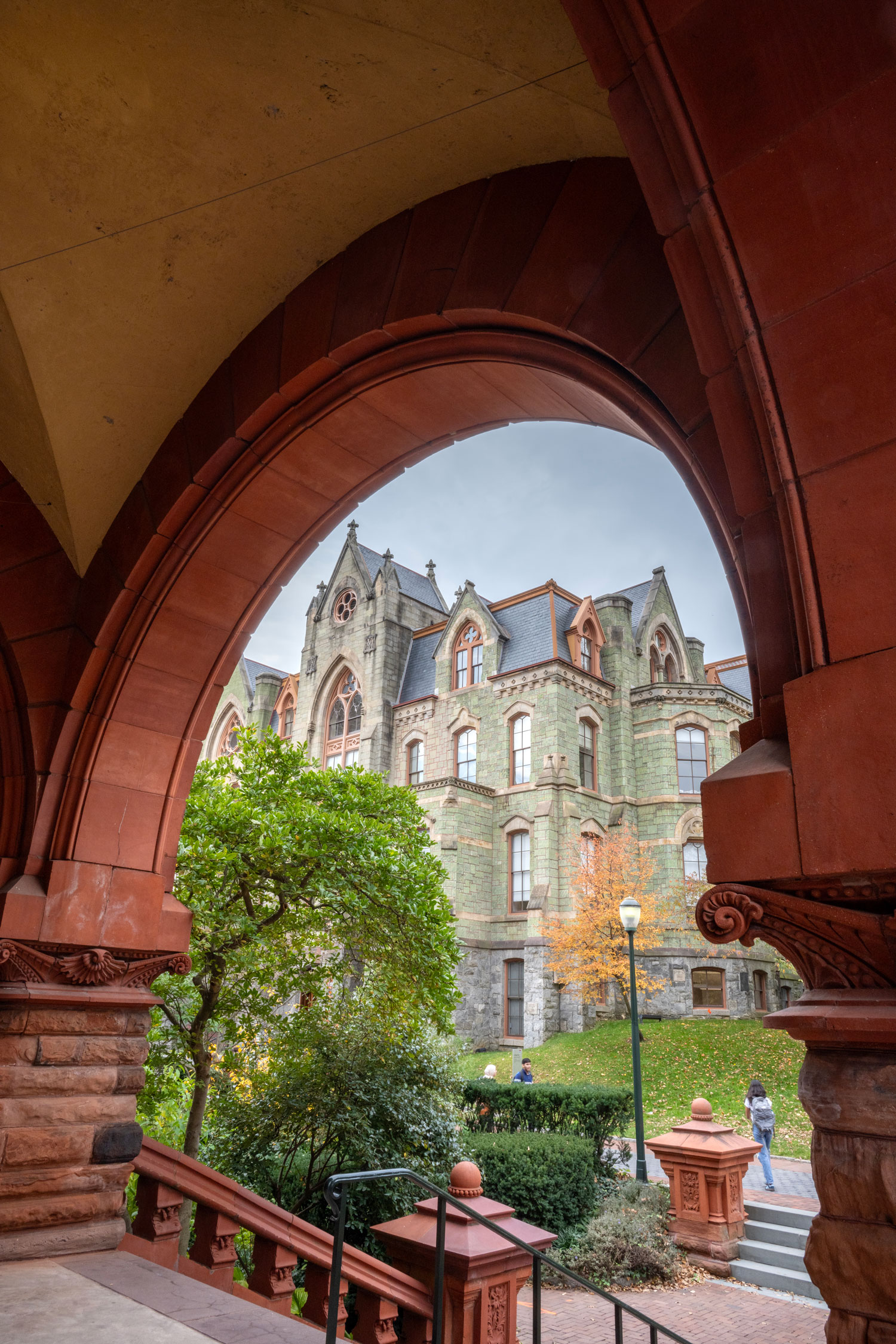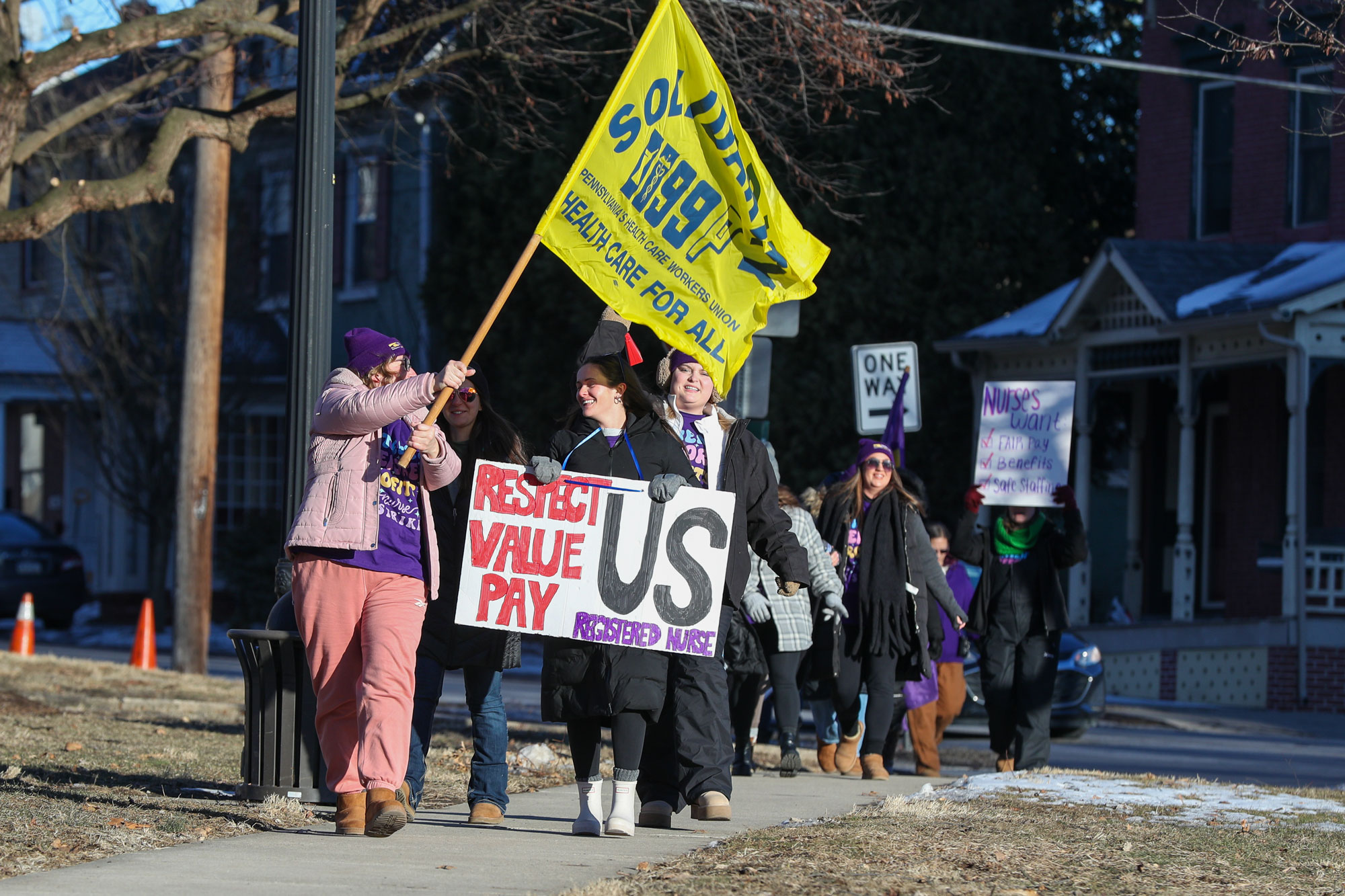Health Care
For PA’s eds & meds, a funding crisis upends work, healthcare and the economy
As the Trump administration continues its war on higher education and research, public health stakeholders are sounding the alarm over the damage to come.

SHANA NOVAK/GETTY IMAGES; BLACKRED/GETTY IMAGES
It sounds like a modern take on a dystopian doctoral thesis: studying the physical and psychological effects of rapid, repeated and unexplained downgrading of key infrastructure on the lives of those responsible for maintaining it and those whose lives depend on it.
But for the Pennsylvanians in the health and research space experiencing the real-time effects of Trump 2.0, they’re feeling less like lab rats and more like deer in headlights.
Since President Donald Trump took office in January, the Department of Government Efficiency, headed by Republican megadonor Elon Musk, has indiscriminately fired more than 120,000 workers while downsizing and dismantling federal agencies. Those firings hit home in more places than one, with Centers for Disease Control and Prevention workers in Pittsburgh getting laid off and the Internal Revenue Service, Social Security Administration and Veterans Administration all facing more potential cuts.
From “eds and meds” stalwarts like the University of Pennsylvania and the University of Pittsburgh to Penn State’s wide-reaching network – and at institutes of higher education across the commonwealth – federal funding freezes, cuts and policy changes could wreak havoc on academic institutions, the local economies around them and the future of public health efforts and organizations in Pennsylvania.

A researcher at the University of Pennsylvania with more than 20 years in the biological sciences spoke anonymously, fearing backlash against her department, saying that the “attack on academia” puts the “freedom for pursuing the brightest and riskiest ideas” in jeopardy.
“The U.S. is a world leader in research, particularly in the health sciences,” the researcher said, adding that the freezes and cuts to funding could cause the nation to fall behind and miss out on “breakthroughs in health care, drug research and disease prevention.”
The warnings of devastation to not just research advances but to the state’s economic health aren’t just hyperbole: Officials estimate that in 2023, NIH awarded Pennsylvania more than $2.2 billion in grants and contracts, directly supporting nearly 22,000 jobs.
“There’s a multiplier effect of about three-and-a-half to four jobs for every one job in the life sciences,” said Chris Molineau, president and CEO of Life Sciences Pennsylvania, a membership organization representing the ecosystem of life science and research, from biotechnology to pharmaceuticals. “NIH funds are a critical part of the innovation ecosystem.”
Freeze-framing
The Trump administration has sought to decimate federal funding across the board, with research and funding cuts, freezes and changes for the NIH hitting campuses hard. The administration also notified state, county and city health departments that it would cut millions of dollars in grant money supporting programs for sexual health services, mental health and addiction treatment through the Department of Health and Human Services, effective immediately.
Donna Bailey, CEO of Community Behavioral Health, a not-for-profit organization contracted by the City of Philadelphia to provide mental health and substance abuse services for Medicaid recipients, said the region’s care organizations and providers have turned toward advocacy since potential cuts were first floated.
“We have not necessarily gotten actively involved in advocacy work, but we are now,” Bailey told City & State. “We’ve also been talking to state and local elected officials, really just trying to educate people on the Medicaid Assistance Program, have them understand how many people in their district are covered, and with the impact to not only their districts, but the local economy here in Philadelphia.”
The NIH policy change is a continuation of the Trump administration’s larger efforts to freeze funding broadly across federal government agencies and programs, which halted the grant and application review process at the NIH, as well as to enact a range of executive orders impacting grants and contracts in academic and scientific research.
The University of Pennsylvania preemptively imposed a hiring freeze and reduced the number of new doctoral students by a third – and that was before the administration announced it would withhold $175 million in direct funding on top of potential NIH cuts.
Penn State officials estimate the university would lose about $35.2 million in NIH-related funding.
Following the NIH directive, indirect costs – which cover overhead expenses, including lab space and support staff – will be capped at 15% for all research institutions. Such institutions have long negotiated indirect cost rates, with the average rate around 30%; Pitt’s was 59% and Penn’s was 62.5%. Meanwhile, Penn State previously received 27% to 28% of the basic grant value for indirect costs from NIH grants, with some costs potentially reaching 50% to 60% or higher.
For Penn State, if the cap had been in place last year, it would have meant a loss of $18.3 million for research at University Park and $16.9 million for the College of Medicine.
Stephen Herzenberg, an economist and executive director of the Keystone Research Center, told City & State that while many higher education institutions may have some “administrative bloat” and increasing overhead costs, the White House is “taking the approach where it’s hard to believe they’re not going to throw out a lot of babies with some of the bathwater.”
“Competitiveness is going to be compromised,” Herzenberg said.


Thomas P. Foley, president of the Association of Independent Colleges and Universities in Pennsylvania, argued that education and funding research should be a uniting issue and that people of all political persuasions should be in favor of research that benefits society.
“It was a Republican, President Dwight Eisenhower, who was one of America’s best champions for funding science and college research. NASA – and SpaceX, for that matter – would not exist had it not been for his foresight,” Foley told City & State. “The tools and technology we use each day came from labs on college campuses, many right here in Pennsylvania.”
Foley said all 67 of the commonwealth’s counties would be financially impacted by federal research freezes and reductions in financial support. Dauphin County would lose $27 million, Allegheny County would lose $259 million, and Philadelphia County would lose nearly $400 million, the study said.
In response, there have been two “Nationwide Day of Action” demonstrations organized by higher education labor leaders, with Philadelphia’s most recent protest taking place April 9 outside of U.S. Sen. Dave McCormick’s Center City office.
Local officials and Philadelphia Council AFL-CIO members attempted to deliver a letter to McCormick there on behalf of more than 50,000 union workers. The letter demanded that McCormick “publicly oppose all cuts to federal funding for research, healthcare and education,” according to Clancy Murray, a graduate student worker at Penn and the head of the bargaining committee for Graduate Employees Together – University of Pennsylvania.
McCormick’s office didn’t respond to City & State’s repeated attempts for comment.
And on April 22, presidents of nearly 200 U.S. colleges and universities – including a dozen in Pennsylvania – co-signed a letter condemning what they called “unprecedented government overreach and political interference” by the federal government.
“We are open to constructive reform and do not oppose legitimate government oversight. However, we must oppose undue government intrusion in the lives of those who learn, live and work on our campuses,” the letter, from the American Association of Colleges and Universities, said.
Big city blues
While the recent federal funding moves will be felt statewide, the commonwealth’s two biggest cities may be disproportionately affected because of the key role eds and meds play in their respective economies.
Philadelphia has more than a dozen hospitals and massive research universities like Drexel, Penn and Temple, with nine of the city’s top 10 largest private employers and 12 of its 15 largest being eds and meds.
Pittsburgh relies similarly on the University of Pittsburgh – the state’s largest private employer, outside of Walmart, is UPMC – and Carnegie Mellon University.
Labs, contractors and doctoral students are in limbo as departments continue their work while administrators reexamine how they can fund internal costs.
State Rep. Dan Frankel, who represents Allegheny County, said that Western Pennsylvania’s colleges and universities “saved this region economically after the collapse of the steel industry.”
“It’s enormously consequential, and the uncertainty and the anxiety that’s been caused in our community with respect to these cuts, and the kind of wrecking-ball approach that the White House is taking toward our academic research institutions, is really nonsensical,” Frankel said.
The uncertainty created by Trump increases the likelihood of the brightest minds and those seeking to further their education leaving the commonwealth – and the country – post-graduation or before.
Many in the life sciences sector believe the United States, once a haven for health care research and international students pursuing higher education, could experience unprecedented brain drain. And for a state like Pennsylvania, where an aging population makes attracting new workers even more important, funding cuts could have even longer-term consequences.
“If you’re a great young person coming out of school and you were considering a career in biomedical research here in the United States, you might be thinking twice about it,” Frankel said. “It’s really presented an opportunity for our competitors in other countries to take our talent and create a brain drain for these institutions.”
The Penn researcher worries that “young people thinking about research” may begin to look elsewhere and pursue career paths that may not lead them to Pennsylvania, reversing a dynamic in which the state’s life sciences sector has been able to attract researchers from around the world.
“There was a dedication to science,” they said. “What will be politically correct and accepted next?”
Cause and effect
Federal-level changes haven’t stopped local and state officials from taking action.
There are three federal lawsuits, with plaintiffs including the Association of American Universities and several colleges, to block the NIH indirect cost cap, and researchers and professors have protested for scientific research – with Carnegie Mellon and Penn joining the one suit against HHS and NIH.
Many organizations and leaders, including Molineau and Foley, have spoken out and met with the state’s congressional delegation to voice concerns about research cuts.

Molineau said the state would be going in the right direction if Gov. Josh Shapiro’s proposal for a $50 million innovation fund comes to fruition in this year’s budget.
Shapiro also proposed a matching fund for the state to couple with those receiving federal dollars through a Small Business Innovation Research Grant. As it stands, Pennsylvania is one of just 14 states that doesn’t have an SBIR matching program.
Molineau said innovation will be key to strengthening the state’s economy and making the it a more attractive destination for those in the life sciences.
Funding difficulty in research “is not unique to Pennsylvania, and it’s not unique to the life sciences, but our companies are very accustomed to tackling the most challenging problems, and they continue to push forward,” Molineau said. “It’s a high-risk business, but they recognize that there are still thousands of diseases affecting millions of patients around the world who are waiting for our scientists to succeed.”
Donna Bailey sounded a similar note of caution, warning that the broader public health impacts will be felt statewide.
“People are going to continue to seek care, whether it’s behavioral health care or physical health care, but they’re just going to end up using high-cost acute services like emergency departments or crisis response centers rather than getting that ongoing preventive care,” Bailey said. “We’ll see higher costs in terms of uncompensated care, which we know will greatly impact hospitals and clinics here in Philadelphia that are already struggling.
“You think about this network of providers we have” in Philadelphia, she added. “They do business here, they hire people here. So there really is a ripple effect outside of specifically the Medicaid program. It’s really going to impact the whole economic infrastructure here.”
